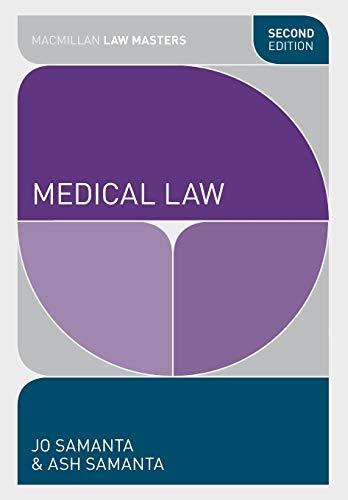Question
1. Which statutory construction approach did Justice Marshall adopt in ruling that the mining claim was forfeited because the renewal notice was filed one day
1. Which statutory construction approach did Justice Marshall adopt in ruling that the mining claim was forfeited because the renewal notice was filed one day late?
2. Is this result fair and just?
3. If the court follows the plain meanin grule, is it required to confine its analysis to the specific statutory provision at issue or may it consider the context of the entire statute? One court has stated: "Each section of a statute should be read in the context of the overall policy of the legislation in order to avoid frustrating legislative intent. See, e.g., Crandon v. United States, 494 U.S. 152, 158 (1990) (stating that in determining the meaning of a statute, we look not only to the particular statutory language, but to the design of the statute as a whole and to its object and policy); Pension Benefit Guar. Corp. v. White Consol. Indus., Inc., 998 F.2d 1192, 1198 (3d Cir. 1993) (asserting that the language of a statute must be analyzed against the background of the statute as a whole and its legislative purpose)." Is this approach consistent with the plain meaning rule? This is precisely the issue that split the United States Supreme Court when deciding whether tax credits under the Affordable Care Act could be applied to purchases on federally-created health exchanges or only on state-established exchanges. King v. Burwell, 135 S. Ct. 2480 (2015). The language of the specific provision at issue referred to insurance plans purchased through "an Exchange established by the State." But Chief Justice Roberts writing for the majority held that it also included exchanges established by the federal government. As he explained: If the language is plain, we must enforce it according to its terms. But oftentimes the "meaningor ambiguityof certain words or phrases may only become evident when placed in context." So when deciding whether the language is plain, we must read the words "in theircontext and with a view to their place in the overall statutory scheme." Our duty, after all, is "to construe statutes, not isolated provisions." (Citations omitted.) In dissent, Justice Scalia responded: The Court holds that when the Patient Protection and Affordable Care Act says "Exchanges established by the State" it means "Exchanges established by the State or the Federal Government." That is of course quite absurd, and the Court's many pages of explanation make it no less so.
[T]he plain, obvious, and rational meaning of a statute is always to be preferred to any curious, narrow, hidden sense that nothing but the exigency of a hard case and the ingenuity and study of an acute and powerful intellect would discover. (Citation omitted.) * * * * I wholeheartedly agree with the Court that sound interpretation requires paying attention to the whole law, not homing in on isolated words or even isolated sections. Context always matters. Let us not forget, however, why context matters: It is a tool for understanding the terms of law, not an excuse for rewriting them.
4. If the language is clear, should courts ever consider legislative history to confirm or refute the plain meaning? According to the Seventh Circuit, when a statute is unambiguous, the court need never consider legislative history. McCoy v. Gilbert, 270 F.3d 503 (7th Cir. 2001). On the other hand, the Ninth Circuit has concluded that although the plain language is the starting point for statutory construction, the court should consider the entire law, including its object and policy, and should consider legislative history even where the plain language is unambiguous where legislative history clearly indicates that Congress meant something other than what it said. Carson Harbor Village, Ltd. v. Unocal Corp. 270 F.3d 863 (9th Cir. 2001). Which approach is better?
5. Why does the Court in a footnote refer to all the other statutes using the "prior to" language? Are these statutes relevant to the interpretation of the statute at issue?
Textbook Source: Johns, Margaret Z.. The United States Legal System: An Introduction, Fourth Edition (p. 137). Carolina Academic Press.
Step by Step Solution
There are 3 Steps involved in it
Step: 1

Get Instant Access to Expert-Tailored Solutions
See step-by-step solutions with expert insights and AI powered tools for academic success
Step: 2

Step: 3

Ace Your Homework with AI
Get the answers you need in no time with our AI-driven, step-by-step assistance
Get Started


